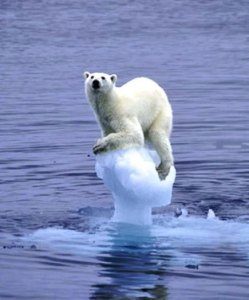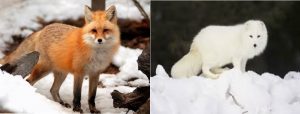We’ve all seen it, the iconic lone polar bear stranded on the only ice in view. It has become the poster-boy for climate change (CC). CC is impacting almost every habitat on earth, but is the impact it’s having on Arctic organisms as bad as we’re made to believe?

The climate is changing. This mainly due to human’s releasing greenhouse gases into the atmosphere, causing the global phenomenon, CC. With increasing temperatures, melting ice stocks and changing ocean currents and weather, CC is one of the greatest challenge facing our generation (Steinfield et al., 2006).
The Arctic is expected to experience the most dramatic change out of any place on Earth (WWF, n.d). It is warming at twice the rate of the globe, a trend set to continue with global temperatures predicted to increase 1.4-5.8°C between 1990-2100 (Naware, 2015; Vihma, 2014). However, worryingly the so-far moderate warming has already impacted Arctic organisms; directly, through the immediate impacts, but also indirectly, by changing ecological interactions, such as predation and habitat distribution (Nahrgang et al., 2014). Heralding changing ecosystems and communities in the region.
It’s getting hot in here, shame polar bears can’t take off their clothes…
As temperature continues to rise, animals are moving poleward, to escape the heat or expand their territories (IPCC, 2007). This has caused ‘the clash of the animals’. For example, Red Foxes are migrating poleward placing their northern counterpart the Arctic Fox under threat (Post et al., 2009). The Red Fox is bigger and more aggressive, leading to a decline in populations of Arctic Foxes (Merchant, 2011). These invasions alter communities and carry threats of hybridization and increased disease (FAO, 2012). As the globe continues to warm, we will witness more unprecedented clashes like this…

Increasing temperatures are altering the life-cycle events of birds, insects and plants. Bringing forward migration and reproduction. The Buff-breasted sandpiper is now nesting 10-days earlier due to increasing temperatures in the Arctic (Hattam, 2009).
‘If you meet a woman start talking about global warming, it’s a real icebreaker…’
The extent and thickness of ice coverage in the Arctic has reduced by 700,000m2 compared to historical levels (1981-2010) (EPA, 2016). This has negatively impacted species that rely on the ice for prey, reproduction and predator avoidance (Post et al., 2009). This includes Walruses, who use sea ice to rest and reproduce, but now use land instead (Badore, 2014). This has been linked to decreasing populations, meaning it is so-far unclear if they will be able to successfully adapt. Changing extent and timing of sea ice formation impacts ecosystem resilience by affecting lower levels of the food chain, thereby impacting predators such as Polar Bears and Walruses who depend on them to survive (Derocher, 2004).

So yes, the impacts are bad and possibly irreversible. The entire globe will be impacted through CC effecting the services the Arctic provides us with, such a climate regulation and natural resources (Post et al., 2009). So, what happens in the Arctic doesn’t just stay in the Arctic…
[Word count: 500]
References:
Badore, M. (2014). This is what it looks like when 35,000 walrus can’t find enough sea ice. [Online] [Last accessed: 20/03/2017] [Accessed at: http://www.treehugger.com/climate-change/what-it-looks-when-35000-walrus-cant-find-enough-sea-ice.html]
Derocher, A. (2004). Polar Bears in a Warming Climate. Integrative and Comparative Biology, 44(2), pp.163-176.
EPA. (2016). Climate Change Indicators: Arctic Sea Ice. [Online] [Last accessed: 19/03/2017] [Accessed at: https://www.epa.gov/climate-indicators/climate-change-indicators-arctic-sea-ice]
FAO. (2012). Wildlife in a changing climate. [Pdf]. [ Last accessed: 12/02/2017] [Accessed at:
http://www.fao.org/docrep/015/i2498e/i2498e.pdf]
Hattam, J. (2009). ‘Unsung’ Species Stressed by Climate Change Too. [Online]. [Last accessed: 20/03/2017] [Accessed at: http://www.treehugger.com/natural-sciences/unsung-species-stressed-by-climate-change-too.html]
IPCC. (2007). Climate Change 2007: Working Group II: Impacts, Adaptation and Vulnerability. [Online] [Last accessed: 18/02/2017] [Accessed at: https://www.ipcc.ch/publications_and_data/ar4/wg2/en/ch1s1-3-5-2.html]
Merchant, B. (2011). Foxfight: Climate Change Causing Arctic & Red Foxes to Clash. [Online]. [Last accessed: 19/03/2017] [Accessed: http://www.treehugger.com/clean-technology/foxfight-climate-change-causing-arctic-red-foxes-to-clash.html]
Nahrgang, J., Varpe, Ø., Korshunova, E., Murzina, S., Hallanger, I., Vieweg, I. and Berge, J. (2014). Gender Specific Reproductive Strategies of an Arctic Key Species (Boreogadus saida) and Implications of Climate Change. PLoS ONE, 9(5), p.e98452.
Naware, R. (2015). 10 reasons why climate change in the Arctic affects us all. [Online]. [Last accessed: 11/03/2017] [Accessed at: https://www.earthhour.org/blog/10-reasons-why-climate-change-the-arctic-affects-us-all]
Post, E., Forchhammer, M., Bret-Harte, M., Callaghan, T., Christensen, T., Elberling, B., Fox, A., Gilg, O., Hik, D., Hoye, T., Ims, R., Jeppesen, E., Klein, D., Madsen, J., McGuire, A., Rysgaard, S., Schindler, D., Stirling, I., Tamstorf, M., Tyler, N., van der Wal, R., Welker, J., Wookey, P., Schmidt, N. and Aastrup, P. (2009). Ecological Dynamics Across the Arctic Associated with Recent Climate Change. Science, 325(5946), pp.1355-1358.
Schofield, O., Ducklow, H., Martinson, D., Meredith, M., Moline, M. and Fraser, W. (2010). How Do Polar Marine Ecosystems Respond to Rapid Climate Change? Science, 328(5985), pp.1520-1523.
Steinfeld, H. (2006). Livestock’s long shadow. 1st ed. Rome: Food and Agriculture Organization of the United Nations. Pp. xxi
Vihma, T. (2014). Effects of Arctic Sea Ice Decline on Weather and Climate: A Review. Surveys in Geophysics, 35(5), pp.1175-1214.
WWF. (N.d). Factsheet: Effects of climate change on arctic ecosystems. [Online]. [Last accessed: 10/03/2017] [Accessed at: https://c402277.ssl.cf1.rackcdn.com/publications/396/files/original/
Effects_of_Climate_Change_on_Arctic_Ecosystems_fact_sheet.pdf?1345753524]
Recent Comments